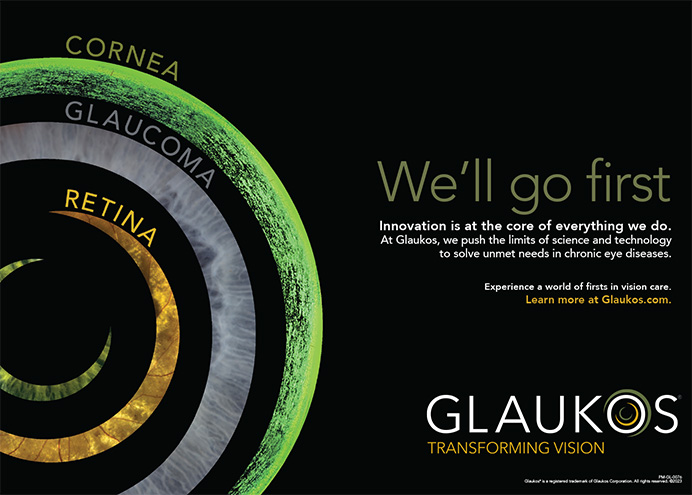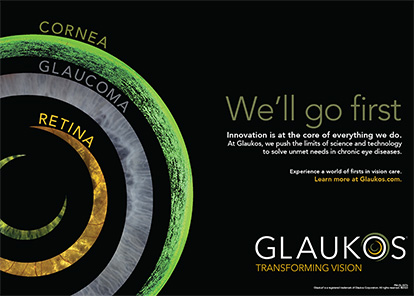In recent years, the results of laser vision correction have steadily improved. Most patients now achieve better than 20/20 UCVA, and more patients than ever before are reporting lower rates of night vision symptoms and higher rates of satisfaction. A number of diagnostic and treatment advances have contributed to these gains, including better laser algorithms, iris registration, and the ability to create LASIK flaps with the femtosecond laser. Perhaps the most important technological improvement, however, is related to the quality of the data used to guide the laser ablation.
CONVENTIONAL TO CUSTOMIZED
In conventional treatments, including those designed to minimize average spherical aberration by “optimizing” an ablation, a phoropter-derived manifest refraction is used to create the ablation pattern. A wavefront-guided (WFG) treatment typically uses a Hartmann-Shack aberrometer— similar to that used to enhance the optical systems of space telescopes—to design a customized treatment. Compared with conventional treatment profiles, WFG ablations have been shown to improve contrast sensitivity, reduce glare and halos, and improve functional night vision.1-3 These advantages are partly due to the correction of higher-order aberrations (HOAs). My colleagues and I demonstrated that the average root mean square error in the eyes of patients presenting for refractive surgery is 0.34 μm ±0.11. We also showed that the majority of eyes (57%) have an HOA root mean square greater than 0.3 μm, which is the cutoff many have identified as benefiting from a WFG ablation profile.4 Certainly, eyes with higher levels of HOAs are not just rare outliers. Even in eyes with lower levels of HOAs, I believe that a WFG procedure is beneficial.
HIGH-RESOLUTION ABERROMETRY
A high-resolution aberrometer, the iDesign (Abbott Medical Optics Inc., not available in the United States), is intended to further improve the quality of the wavefront data that can be captured and used to guide a WFG treatment. This aberrometer can capture up to five times more data points than the Visx WaveScan Wavefront System (Abbott Medical Optics Inc.).
Initial evaluation of the new aberrometer at Optical Express centers in the United Kingdom and Japan suggests that the iDesign is easy to use, providing refractive surgeons with a simple and quick transition from the WaveScan. Patient throughput is improved, because the device consolidates wavefront aberrometry, gradient topography, autorefraction, pupillometry, and keratometry into a single diagnostic device.
Results with high-resolution aberrometry have been evaluated in 675 eyes of 348 patients in the United Kingdom and 321 eyes of 162 patients in Japan undergoing refractive surgery (unpublished data). The Japanese patients were younger, more myopic, and more likely to be male than those in the United Kingdom. The range of refractive errors treated with the new aberrometer was very large, from -9.50 to +4.25 D in the UK study with up to 5.50 D of astigmatism and an even broader range of myopia in Japan.
We also compared our results to those of very large matched cohorts (nearly 29,000 eyes) treated with standard aberrometry in several countries (unpublished data). These large contemporary cohorts were treated in 2012 based on aberrometry from a well-established aberrometer with highly refined nomograms.
Study Results
The predictability of the correction with iDesign has been excellent. In the UK study, 90% of eyes had a manifest spherical equivalent within 0.50 D and 97% within 1.00 D of the intended correction 1 month postoperatively. In Japan, 84% were within 0.50 D, and 100% were within 1.00 D of the intended correction 1 month postoperatively. The correlation coefficient of attempted versus achieved manifest spherical equivalent was 0.97 in both studies.
A significant advantage of higher-resolution aberrometry seems to be in the measurement and correction of astigmatism. This has been a strength of WFG treatments, so we were skeptical that it could improve by much. Use of the higher-resolution aberrometer, however, resulted in fewer outliers, less chance of an axial shift, and a tighter correlation coefficient compared with standard aberrometry (Figure 1).
In the UK study, 1 month postoperatively, mean cylinder was reduced to -0.18 D ±0.25, leaving 95% of the eyes with 0.50 D or less of astigmatism. This is the best cylindrical correction I have observed after an excimer laser procedure.
UCVA, the measure by which patients are most likely to judge their outcome, was better than 20/20 in more than 87% of all eyes and 93% of myopic eyes in the UK study. In Japan, 98% of all eyes achieved better than 20/20 UCVA. Consistent with what we know about the correlation between UCVA and satisfaction, patients were more likely to be “very satisfied” with their vision after surgery compared with patients who had standard aberrometry (Figure 2).
SUCCESSFUL EARLY EXPERIENCE
After correcting a wide range of refractive errors in nearly 1,000 eyes with treatments guided by the iDesign, we found excellent refractive predictability and UCVA, extraordinary cylindrical correction, and high levels of satisfaction among patients. Importantly, these results were achieved for the initial treatments performed with the aberrometer. I anticipate there will be even better results with increased experience and refinement.
Steven C. Schallhorn, MD, is in private practice in San Diego and is global medical director of Optical Express. He is a consultant to Abbott Medical Optics Inc. Dr. Schallhorn may be reached at scschallhorn@yahoo.com.
- Schallhorn SC, Farjo AA, Huang D, et al, American Academy of Ophthalmology. Wavefront-guided LASIK for the correction of primary myopia and astigmatism: a report by the AAO. Ophthalmology. 2008;115(7):1249-1261.
- Lee HK, Choe CM, Ma KT, Kim EK. Measurement of contrast sensitivity and glare under mesopic and photopic conditions following wavefront-guided and conventional LASIK surgery. J Refract Surg. 2006;22(7):647-655.
- Schallhorn SC, Tanzer DJ, Kaupp SE, et al. Comparison of night driving performance after wavefront-guided and conventional LASIK for moderate myopia. Ophthalmology 2009;116(4):702-709.
- Schallhorn S. Wavefront-guided ablation has no measurable advantage in myopic eyes with high-order aberration less than 0.3 μm–cons. Paper presented at: The American Academy of Ophthalmology Annual Meeting; October 21, 2011; Orlando, FL.


